The Curonian Spit in the Order period
History of the Curonian Spit based on the Order's chronicles and documents
In the Order's chronicles, the Curonian Spit was first mentioned in the Livonian Rhymed Chronicle of the late 13th century. It is described as a strip of land covered with large trees, which was a military road between Sambia and Memel (now Klaipeda. — admin ).
In a document from 1258 on the division of conquered Sambia between the bishop and the order, the "Nestlant Island" is mentioned, which should be understood as the Curonian Spit. The name of the spit as "Curonian" is first encountered in the "Chronicle of the Prussian Land" by Peter von Dusburg, written in the first half of the 14th century.
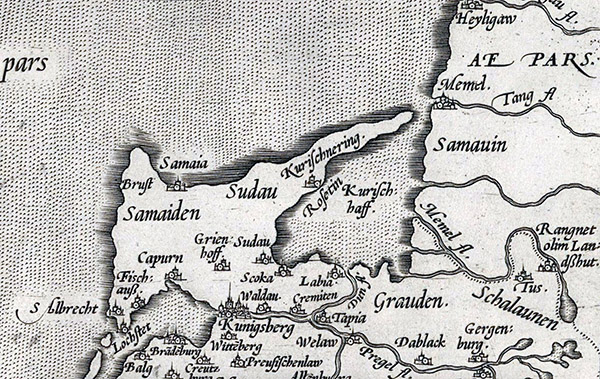
Connecting link
The Curonian Spit was indeed an important strategic object for the Order, since it was the only land route from Sambia through Courland to Livonia in winter, when the waters of the Curonian Lagoon, often referred to in chronicles as a lake, froze, and provided safe passage to any place around the Curonian Lagoon and beyond.
With the final conquest of Sambia in 1258, free access to the spit became possible. The spit became a link with the Memel Castle, built by the Livonians in 1252. It was planned that the castle would become the capital of Courland and the center of trade in the Baltic. These actions allowed the establishment of control over the Curonian Spit. However, in 1264, the Lithuanians, in order to support the Prussian uprising, invaded Sambia through the spit and even besieged the Wehlau Castle (now the village of Znamensk. — admin ).
Invasion of Sambia
In 1283, when the Order was conquering the last independent tribes in the south-east of the Prussian lands, the Lithuanians again organized a military campaign through the Curonian Spit into Sambia, ravaged it and went back to their lands. This event is reflected in the chronicle of Peter von Dusburg:
“In the year of the Nativity of Christ 1283, 800 horsemen from Lithuania in the winter along the Curonian Neria invaded the Sambian land and two of its volosts, namely Abendu and Pobeta, devastated with fire and sword, killing 150 Christians, and since no one offered them resistance, they all left safe and sound.”
As a result, the Order built a castle on the spit called Neuhaus to prevent possible Lithuanian raids. This was also reflected in the chronicle of Peter von Dusburg:
“Brother Conrad, the master, as a wise and perspicacious man, believing that along Neria, a road invisible from anywhere, many troubles and troubles could arise again for the brothers and the land of Sambia from the pagans, founded on the said Neria, on the shore of the Salt Sea, a powerful castle called Neuhaus, so that the Lithuanians would not suddenly invade the land of Sambia.”
There was probably a small defensive structure here before, as indicated by the name "Neuhaus" or "Castrum Nova", which means "New Castle".
City and castle
During the subsequent military conflicts, Memel was destroyed in 1293 and 1323. And in 1328, the Livonians handed over control of Memel to the Order. The main goal was to get rid of the financial problems associated with the constant restoration of the city after destruction. Later, the castle and the city of Memel were destroyed several times during the Order-Lithuanian conflicts for Samogitia in 1360, 1365, 1379, 1393 and in 1401. The city was destroyed in 1409, when another Samogitian uprising occurred, which marked the beginning of the Great War between the Order and the Polish-Lithuanian Union.
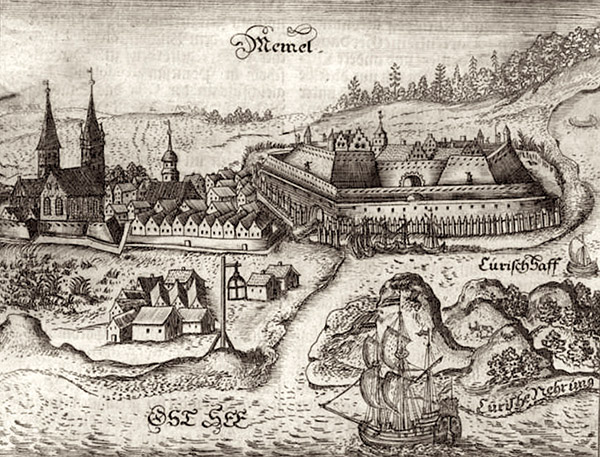
During the Order-Lithuanian conflicts throughout the 14th century, Lithuanian troops repeatedly invaded through the Curonian Spit and the waters of the Gulf, and the Order struck back. Wigand von Marburg mentions in his chronicle how the Order's Marshal Henning Schindekopf overtook the retreating Lithuanian army across the ice of the Gulf:
“Brother Schindekopf followed them and on the lake called Kurishe Hab, he captured 45 noblemen from them, in addition to those whom he ordered to be killed and drowned.”
The above-mentioned destruction of Memel led to a major construction of the city and castle at the beginning of the 15th century. The construction work, carried out under the supervision of specialists, amounted to 10% of the annual expenses of the order in the years 1398-1409 and is reflected in the records of the treasurer. The greatest expenditure occurred in 1402-1403. Gradually, the expenditure decreased until 1409, when Memel was again destroyed, and then, due to the war, the work was never completed.
Road reports
In 1422, with the end of another Order-Polish war, the military significance of the Curonian Spit began to weaken, giving way to a communication role. This is due to the conclusion of a peace treaty at Lake Mielno in 1422, between the Order and the allied Poland and Lithuania. According to this treaty, the Teutonic Order promised to abandon its claims to Samogitia and clear boundaries between the Order and Lithuania were stipulated.
Military reconnaissance routes passed through the spit and the bay, collected in the collection "Litauische Wegeberichte", or "Lithuanian road reports", created in the late 14th - early 15th centuries. Some routes passed through the Curonian Spit, and Rossitten (now Rybachy. - admin) is mentioned there as a stopping point on the road to Windenburg (approximately at this place is the Lithuanian settlement of Vente. - admin ) and the Memel (Neman) delta. And the routes themselves passed in winter through the ice-bound bay. At the end of the 14th century, an order fortified castle appeared in Rossitten, near which a village and an inn arose. And at the end of the 19th century, a medieval burial site from the 13th-15th centuries was excavated near Rossitten.
Across the sand spit
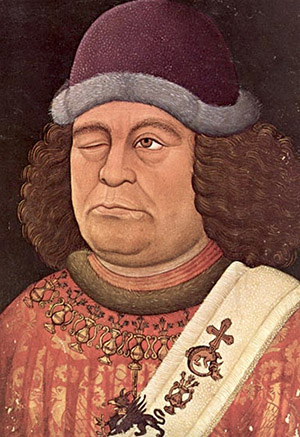
During the military conflicts of the 14th-15th centuries, the Order's Prussia was periodically visited by the Order's leaders, as well as by real celebrities of that time. In 1434-35, the Order's Supreme Marshal Konrad von Erlichshausen, the future Grand Master, was on the spit. In the autumn of 1434, he bought fish from local fishermen in Rossitten, and in the summer of 1435, in Zarkau (now Lesnoy. - admin ), he gave 7.5 shillings to the Curonians he met. The diplomat and the last minnesinger, Oswald von Wolkenstein, who visited Prussia at least twice, in 1399 and 1402, also visited the spit. In his songs, Oswald repeatedly mentions his visits to France, Spain, England, Denmark, Sweden, Sicily, Cyprus and Crete, Turkey, Crimea, Palestine, Egypt, Persia, the lands of the Tatars, Russia, Lithuania and Prussia, which is mentioned five times.
In one of his works there is also a mention of the Curonian Spit, along which his path ran:
"Through Russia, Prussia, Estonia
to Lithuania, Livonia, across the sand spit"(From the song Durch Barbarei, Arabia).
To prevent possible raids by Lithuanians, the Order built castles and fortifications in several places on the spit.
On the mainland, separated from the spit by a strait, was the Memel Castle, founded by the Livonians in 1252. In 1328, the castle was transferred to the Order and became the center of the Komturstvo, one of the independent administrative-territorial units of the Order's Prussia.
No fixed location
In 1283, after a raid on Sambia by Lithuanians who had penetrated through the spit, the Landmeister of the Order in Prussia, Conrad von Thierberg, ordered the construction of a castle on the spit, which was named Neuhaus, or New Castle: “he founded on the aforementioned Neria, on the shore of the Salt Sea, a powerful castle called Neuhaus, so that the Lithuanians would not suddenly invade the land of Sambia.”
The location of this castle has been the subject of debate among historians since the end of the 19th century. The castle was "placed" both at the base of the spit near Kranz (now Zelenogradsk. — admin ), and on the spit itself, between Rossitten and Pillkoppen (now Morskoe. — admin ), and even in Pillkoppen itself.
When dividing the territory of Sambia in 1331, according to the agreement between the bishop and the order, the castle of Neuhaus ("Nuinhus") is mentioned as a landmark when drawing the borders. According to this agreement, the castle was located before the beginning of the spit, on the outskirts of the modern city, by the Trostyanka River. Even in the pre-Order period, there was a fortified settlement there, called Gorbek. It is more than likely that Landmeister von Tierberg built a new fortification on this site, and therefore the castle was called "castrum novum" or Neuhaus. However, it is suggested that the castle was originally located in Pillkoppen, which also had a pre-Order fortified settlement. According to unconfirmed evidence from the 17th-18th centuries, the remains of the Neuhaus fortification were moved to Königsberg, "to the majestic Tiergarten."
Rossitten Castle
Another Order castle on the Curonian Spit was Rossitten. It was probably built in the second half of the 14th century. In the mentioned Lithuanian travel reports of the 1380s, Rossitten is indicated as a place to spend the night on the route through the lagoon to Samogitia, in the Šiaudovu region. It is known that at the beginning of the 15th century, the castle became the center of a pflegerstvo, a small administrative unit of the Order's Prussia. At the castle, there was a position of fishmeister - an official responsible for fishing.
There was a settlement near the castle, which had at least two inns. In 1470, Grand Master Heinrich von Richtenberg granted the innkeeper Hans Schröter "a courtyard located in front of our castle Rossitten, with one acre of land and two acres of meadow, free fishing and free firewood in our forests for their necessary life support." Rossitten had a brick factory capable of producing large quantities of bricks. From the records of the treasurer, it is known that bricks from Rossitten were delivered to Memel.
The last mention of the existing Rossitten Castle is contained in a treaty of 1525, where it, along with Königsberg, Lochstedt and other castles, was granted by the king to Duke Albrecht. According to unconfirmed evidence, in the middle of the 17th century, the ruins of the castle and its cellars were still visible in the area. The crumbling Rossitten Castle is the setting for the Gothic novel "Majorat" by the Königsberger Hoffmann, in which the castle is practically one of the heroes of the story.
Letter from Nidden
In the northern part of the spit there was an inn called Treieros, mentioned in documents from the beginning of the 15th century. Later, the settlement of Karweiten arose on the site of this settlement. In addition to it, there was an important point called the "horse meadow". From the name it is clear that this was a place where horses were kept to serve travelers, mentioned almost simultaneously with the inn.
German and Russian historians and archaeologists mention the existence of several transverse ramparts of defensive significance on the spit. Such ramparts, both pre-Order and Order periods, were located in the area of Pillkoppen, Sarkau and at the base of the spit.
Another settlement on the spit that emerged during the Order period is Nidden (now Nida. — admin ). The first mention of it dates back to 1429.
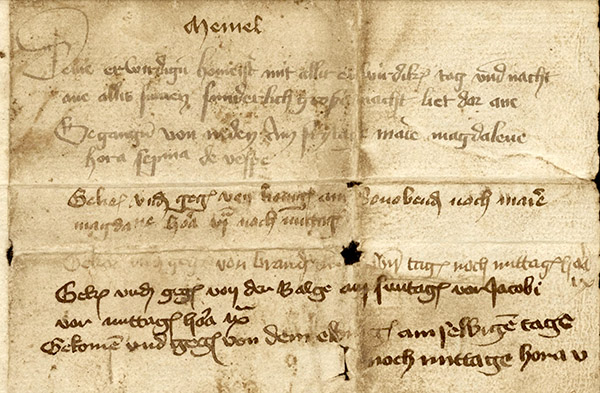
There is a letter sent by the commander of Memel to the Grand Master on July 23, 1429. What is interesting is not the letter itself, which talks about buildings in Memel and nearby. On the back of the letter are postmarks. The letter was sent from Nidden, apparently where the commander of Memel was at the time, "on Saturday after Mary Magdalene's Day at seven o'clock." According to the marks, the letter went through Königsberg, Brandenburg (now Ushakovo. — admin ) and Balga. "On Monday at five o'clock" it arrived in Elbing (now Edblong. — admin ). The Master was probably there at the time. Thus, the letter covered a distance of about 200 km in two days. For example, letters from Königsberg to Elbing took a day, and from Riga to Marienburg (now Malbork. — admin ) more than a week.
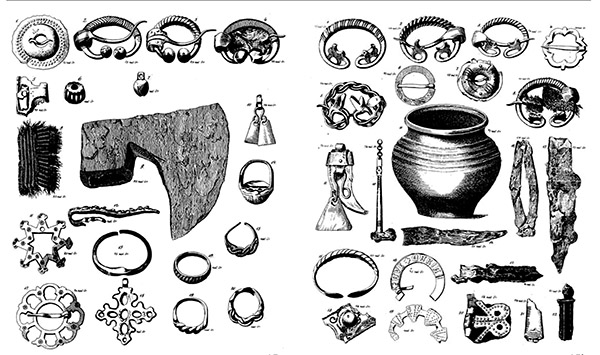
Unfortunately, only chronicles and letters have preserved evidence and mentions of the spit's order period to this day; time has not preserved any buildings. Only archaeological finds reveal some details of life here in the Middle Ages.
Sources and literature:
GStA PK, XX. HA, OBA.
Joachim E. The Marienburger Tresslerbuch of the Year 1399–1409. Königsberg, 1896.
Scriptores Rerum Prussicarum. The social changes of the Pre-Russian Empire to the bottom of the military order. Erster Band. Hrsg. Theodor Hirsch, Max Töppen, Ernst Strehlke. Leipzig: Verlag von S. Hirzel, 1861.
Scriptores Rerum Prussicarum. The social changes of the Pre-Russian Empire to the bottom of the military order. Zweiter Band. Hrsg. Theodor Hirsch, Max Töppen, Ernst Strehlke. Frankfurt am Main: Minerva, 1965.
Thielen PG The gross volume of the German Ritterordens (1414-1438). N. G. Elwert, 1958.
Woelky CP, Mendthal H. Book of Samland's Bisthums. Leipzig, 1891.
Ziesemer W. The gross volume of German Orders. Danzig: Kafemann, 1921.
Beckherrn C. Garbick. In the original manuscript, Bd. 35, 1898.
Bezzenberger A. The Kurische Nehrung and Its Behavior // Research into German Lands and Peoples. Bd. 3, No. 4. Königsberg, 1889.
Hoffheinz GT Where is Burg Neuhaus? // Original Monthly Report, vol. 15, 1878.
Kleeman O. About the witches' lives in the wilderness and about the stories in the Kurdistan region. // AltPreußen, Bd. 4, 1939.
Predecessor D. Amendment of the Lithuanian Constitution in periods 1283-1325. Toruń, 2004.
Thiel PG The adoption of the Ordenstaates of the United States. Cologne, 1965.
Willoweit G. Wirtschaftsgeschichte des Memelgebietes. Bd. 1, Marburg, 1969.
